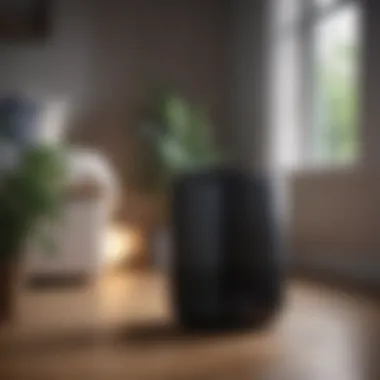Expert Guide: How to Safely Disinfect the Air in Your Home for a Healthier Environment


In today's world, the importance of a clean and healthy living environment cannot be overstated. With airborne contaminants posing a threat to our well-being, knowing how to effectively disinfect the air in your home is key to creating a healthy indoor space. This comprehensive guide will delve into various methods and tools that can help eliminate harmful particles in the air, enhancing the overall air quality and promoting a more comfortable living environment.
Understanding Air Disinfection
Before delving into the practical steps of disinfecting the air in your home, it is crucial to grasp the fundamentals of air purification. Air disinfection refers to the process of removing or killing harmful microbes, allergens, and pollutants present in the air. Understanding the sources of indoor air pollution, such as dust, pet dander, and volatile organic compounds (VOCs), is essential for targeted air purification.
Key Points to Consider:
- Identifying common sources of indoor air pollution
- Recognizing the impact of poor air quality on health
- Exploring the different types of airborne contaminants
Relevance to Your Home:
Effective air disinfection is not just about cleanliness; it directly impacts your health and well-being. By implementing proper air purification techniques, you can create a safer and more rejuvenating indoor environment.
Tools and Methods for Air Disinfection
Now that you understand the importance of air disinfection, it's time to explore the practical tools and methods available to purify the air in your home. From air purifiers and UV sterilization to natural ventilation techniques, there are various approaches to improving indoor air quality.
Air Purifiers:
Investing in a high-quality air purifier can significantly reduce airborne particles and improve air circulation in your home. HEPA filters are particularly effective in capturing small particles like dust mites and pollen.
UV Sterilization:
UV light has been shown to kill bacteria and viruses in the air, providing an added layer of protection against airborne pathogens. UV sterilization units can be installed in HVAC systems or used as standalone devices.
Natural Ventilation:
Opening windows and doors to allow fresh air to circulate can be a simple yet effective way to reduce indoor air pollutants. Utilizing natural ventilation strategies, such as cross ventilation, can help maintain a healthy airflow in your home.
Key Considerations:
- Understanding the effectiveness of different air disinfection methods
- Choosing the right tools based on your specific needs
- Integrating air purification into your daily routine for long-term benefits
Relevance to Your Home:
By incorporating advanced air purification tools and methods into your home environment, you can create a healthier and more sustainable living space for you and your family.


Maintenance and Regular Checks
Ensuring the continued effectiveness of your air disinfection measures requires regular maintenance and monitoring. From replacing air filters to scheduling professional HVAC inspections, proactive steps can prolong the lifespan of your air purification systems.
Filter Replacements:
Regularly changing filters in your air purifiers and HVAC units is essential for optimal performance. Clogged filters can reduce efficiency and compromise air quality.
Professional Inspections:
Engaging HVAC professionals to inspect and clean your air ducts and ventilation systems can uncover potential issues and ensure efficient airflow.
Ongoing Monitoring:
Monitoring indoor air quality using air quality monitors can help you assess the effectiveness of your air disinfection efforts and make necessary adjustments.
Key Recommendations:
- Establishing a regular maintenance schedule for air purification systems
- Seeking professional assistance for thorough inspections and maintenance
- Keeping track of indoor air quality indicators for proactive management
Relevance to Your Home:
By staying diligent with maintenance and periodic checks, you can uphold a consistent level of air quality and safeguard your home against airborne pollutants.
Conclusion
Introduction
In the realm of indoor living, ensuring optimal air quality is paramount to fostering a healthy and harmonious environment within our homes. The ability to disinfect the air that we breathe holds immense significance in safeguarding our well-being and elevating the overall quality of our living spaces. By exploring the intricate dynamics of air disinfection, we embark on a journey towards a cleaner, safer atmosphere where we can thrive and rejuvenate.
Understanding the pivotal role that air quality plays in our daily lives unveils a host of benefits that transcend the physical realm. From reducing the risk of respiratory ailments to enhancing cognitive function, the impact of purified air resonates deeply within our bodies and minds. Furthermore, the considerations surrounding air disinfection extend to creating a sanctuary within our homes, where we can unwind and recharge amidst an environment free of harmful airborne contaminants.
Delving into the intricacies of air disinfection not only empowers us to combat invisible threats but also allows us to curate a space that nurtures our holistic well-being. The enlightening journey ahead will shed light on various methods and tools that can effectively eliminate airborne pollutants, paving the way for a breath of fresh air within the confines of our homes.
Understanding Air Disinfection
Air disinfection is a critical aspect of maintaining a healthy indoor environment. With rising concerns about air quality, understanding how to effectively disinfect the air in your home is crucial. By implementing proper air disinfection techniques, you can significantly reduce airborne contaminants, creating a clean and safe living space. This article delves into various methods and tools that can help you achieve optimal air quality for a more comfortable and healthier lifestyle.


Importance of Air Quality
Air quality plays a vital role in overall well-being, especially within the confines of indoor spaces. Poor air quality can lead to a range of health issues, including respiratory problems, allergies, and other illnesses. By focusing on air disinfection, you can mitigate these risks and foster a healthier living environment. Understanding the importance of maintaining high air quality underscores the significance of effective air disinfection methods.
Common Airborne Contaminants
Indoor air can harbor numerous pollutants and contaminants, contributing to poor air quality. Common airborne contaminants include dust mites, pollen, pet dander, mold spores, and volatile organic compounds (VOCs). These pollutants can trigger allergies, worsen respiratory conditions, and impact overall health. Recognizing and addressing these contaminants is essential for improving indoor air quality and safeguarding your health.
Impact on Health
Poor air quality can have a profound impact on human health. Prolonged exposure to airborne contaminants can result in respiratory issues, skin irritation, headaches, fatigue, and other health problems. Additionally, individuals with pre-existing conditions such as asthma or allergies may experience exacerbated symptoms in environments with poor air quality. Prioritizing air disinfection is crucial for reducing the health risks associated with indoor air pollution.
Methods of Air Disinfection
In this segment of the article, we delve into the crucial topic of Methods of Air Disinfection, which plays a pivotal role in creating a healthy indoor environment. Efficient air disinfection methods are essential for eliminating harmful airborne contaminants and enhancing air quality within homes. By implementing the right techniques, homeowners can enjoy cleaner and fresher air, promoting overall well-being and comfort. These methods not only help in reducing the presence of allergens and pollutants but also contribute to creating a more pleasant living space.
Natural Ventilation
Natural ventilation stands as a fundamental method for air disinfection, relying on the influx of fresh air from the outdoors to improve indoor air quality. Opening windows and doors strategically allows for the circulation of air, helping in dissipating indoor pollutants and maintaining a well-ventilated environment. This approach is particularly beneficial in reducing humidity levels and preventing the buildup of stale air. By harnessing the power of natural airflow, homeowners can effectively mitigate the presence of contaminants and enhance the overall freshness of their homes.
Air Purifiers
Air purifiers are indispensable devices designed to filter out impurities and contaminants from the air, thereby promoting a healthier indoor environment. These innovative gadgets utilize specialized filters to capture dust, allergens, and microbes, purifying the air that circulates within living spaces. By investing in a high-quality air purifier, homeowners can significantly reduce the concentration of pollutants and enhance overall air quality. This method is especially beneficial for individuals with respiratory issues or allergies, providing them with cleaner and fresher air to breathe.
UV-C Light Sterilization
UV-C light sterilization is a cutting-edge technique that involves the use of ultraviolet light to eradicate harmful pathogens and microbes present in the air. This method is highly effective in neutralizing bacteria, viruses, and mold spores, contributing to a safer and healthier indoor environment. By implementing UV-C light sterilization systems, homeowners can target and eliminate airborne contaminants, significantly reducing the risk of respiratory infections and other health issues. This advanced disinfection method offers a proactive approach to ensuring air quality and promoting overall well-being.
Activated Carbon Filters
Activated carbon filters are renowned for their exceptional ability to absorb odors, chemicals, and volatile organic compounds present in the air. These filters work by trapping impurities on their porous surfaces, effectively purifying the air and improving its overall quality. By incorporating activated carbon filters into air purification systems, homeowners can enjoy cleaner and fresher air without the lingering odors or harmful substances. This method is particularly beneficial in households where air quality is a significant concern, providing a reliable solution for combating indoor pollutants.
Ozone Generators
Ozone generators are specialized devices that produce ozone gas to sanitize and deodorize indoor air. These generators work by dispersing ozone molecules, which react with contaminants and neutralize them, resulting in a fresher and cleaner living environment. While ozone generators can be effective in eliminating odors and microbial growth, caution must be exercised during their use due to potential health risks associated with high ozone levels. Homeowners considering this method should carefully follow safety guidelines and use ozone generators in moderation to ensure air disinfection without compromising their well-being.
Best Practices for Air Disinfection


Protecting the air quality inside your home is crucial for a healthy living environment. Implementing best practices for air disinfection plays a vital role in ensuring that you and your family breathe clean, fresh air. By incorporating simple yet effective strategies, you can significantly reduce the presence of airborne contaminants in your indoor space. Regular cleaning, maintaining optimal humidity levels, avoiding smoking indoors, and harnessing the benefits of houseplants are all essential aspects of creating a breathable atmosphere within your home.
Regular Cleaning
Regular cleaning is a fundamental element of maintaining good air quality in your home. Dust, pet dander, pollen, and other particles can accumulate over time, leading to poor air circulation and potential health risks. To combat this, establish a routine cleaning schedule that includes dusting, vacuuming, and mopping floors. Pay particular attention to high-touch surfaces and frequently used areas. Utilize microfiber cloths and natural cleaning agents to minimize the use of harsh chemicals, which can introduce additional toxins into the air. Regular cleaning not only enhances the cleanliness of your home but also contributes to improved air quality, allowing you to breathe easier.
Maintaining Optimal Humidity Levels
Maintaining the proper humidity levels in your home is essential for air disinfection. High humidity can promote the growth of mold and mildew, which release spores into the air and negatively impact respiratory health. On the other hand, low humidity levels can cause dryness and irritation in the throat and nasal passages. Invest in a hygrometer to monitor the humidity levels in your home regularly. Ideally, the humidity should fall between 30-50%. Use a dehumidifier in damp areas and humidifiers in dry regions to achieve and maintain optimal humidity levels for a healthier living environment.
Avoiding Smoking Indoors
One of the most significant contributors to indoor air pollution is smoking. Cigarette smoke contains thousands of harmful chemicals that linger in the air, on surfaces, and in fabrics long after the visible smoke has dissipated. Secondhand smoke poses serious health risks, particularly to children, the elderly, and individuals with respiratory conditions. Protect the air quality in your home by establishing a strict no-smoking policy indoors. Designate a well-ventilated outdoor area for smoking if necessary. By eliminating smoking indoors, you can effectively reduce the presence of toxic substances in the air and promote a safer and healthier environment for everyone.
Houseplant Benefits
Houseplants not only beautify your living space but also serve as natural air purifiers. Certain plants have the ability to remove toxins from the air through a process called phytoremediation. Spider plants, peace lilies, snake plants, and pothos are examples of houseplants known for their air-purifying properties. Additionally, plants increase humidity levels through transpiration, further enhancing the overall air quality. Incorporate houseplants strategically throughout your home, placing them in various rooms to maximize their air-purifying benefits. Regularly dust the leaves and ensure proper watering to maintain the health and effectiveness of your indoor plants for improved air quality.
DIY Air Disinfection Remedies
In the realm of home air disinfection, do-it-yourself (DIY) remedies represent a cost-effective and accessible approach to improving indoor air quality. This section delves into the significance of incorporating DIY techniques to combat airborne contaminants and create a healthier living environment. By exploring the specific elements, benefits, and considerations surrounding DIY air disinfection remedies, homeowners can proactively take charge of their respiratory well-being and elevate the purity of the air in their homes.
Essential Oil Diffusers
Essential oil diffusers have gained popularity as a natural and aromatic way to freshen indoor air. These devices disperse essential oils extracted from plants into the air, not only imparting pleasant scents but also potentially offering antimicrobial properties. By harnessing the power of essential oils like tea tree or eucalyptus, essential oil diffusers can aid in neutralizing germs and enhancing air quality within living spaces. It is important to note the potency of essential oils, as some individuals may be sensitive to strong fragrances.
Vinegar Sprays
Vinegar sprays serve as a versatile DIY solution for disinfecting the air in your home. The acidic nature of vinegar makes it a potent disinfectant against bacteria, viruses, and mold spores. A simple mixture of water and white vinegar can be sprayed into the air or on surfaces to help sanitize and deodorize your living space. However, it is essential to use vinegar in well-ventilated areas to prevent overpowering odors and potential irritation to individuals sensitive to strong smells.
Baking Soda Odor Absorption
Baking soda is renowned for its odor-neutralizing properties, making it a valuable component of DIY air disinfection remedies. Placing open containers of baking soda in various areas of your home can help absorb and neutralize unpleasant smells, creating a fresher environment. Additionally, baking soda can be combined with essential oils to create homemade air freshening sprays or sprinkled on carpets before vacuuming to eliminate lingering odors. Care should be taken not to overuse baking soda, as excessive amounts may leave a powdery residue in your living spaces.
Conclusion
In the realm of ensuring a healthy indoor environment, the conclusion is arguably the most crucial part of this discourse on air disinfection. It serves as the culmination of a wealth of information meticulously presented throughout the article, offering key takeaways and actionable insights for individuals seeking to enhance the air quality within their abodes. The significance of this concluding section lies in its ability to encapsulate the diverse array of methods and best practices elucidated earlier, thereby empowering readers with a comprehensive toolkit to combat airborne contaminants effectively.
One of the primary benefits of the conclusion is its function as a practical guide, distilling complex information into digestible snippets that readers can readily implement. By highlighting the importance of regular cleaning, maintaining optimal humidity levels, avoiding indoor smoking, and leveraging the natural benefits of houseplants, individuals are equipped with clear directives to safeguard their indoor air quality. This actionable approach ensures that the knowledge imparted in this article transcends mere theory, translating into tangible actions that yield tangible results.
Moreover, the conclusion underscores the proactive stance necessary for maintaining a clean and healthy home environment. By emphasizing the significance of adopting DIY air disinfection remedies in conjunction with established methods like air purifiers and UV-C light sterilization, this section encourages a holistic approach to air quality management. It fosters a sense of agency within readers, empowering them to take charge of their living spaces and prioritize their well-being.
Another critical aspect of the conclusion is its role in fostering a sense of awareness and consciousness regarding indoor air quality. By shedding light on the detrimental impact of airborne contaminants on health and well-being, this section urges readers to prioritize air disinfection as a fundamental aspect of home maintenance. Through this heightened awareness, individuals are not only motivated to make immediate changes but are also incentivized to cultivate long-term habits that promote a healthier lifestyle.
In essence, the conclusion acts as a beacon of knowledge and guidance, illuminating the path towards a cleaner and more nourishing indoor environment. By distilling complex information into actionable steps, advocating for a proactive stance, and raising awareness about the importance of air quality, this concluding section cements itself as a cornerstone of this comprehensive guide on air disinfection. It empowers readers to transform their living spaces into sanctuaries of clean, pure air, fostering a sense of well-being and vitality within the walls of their homes.



